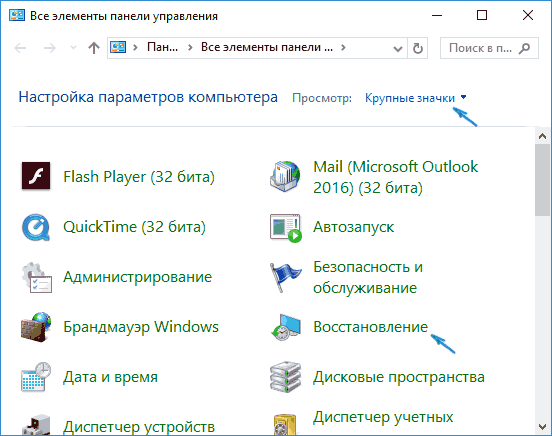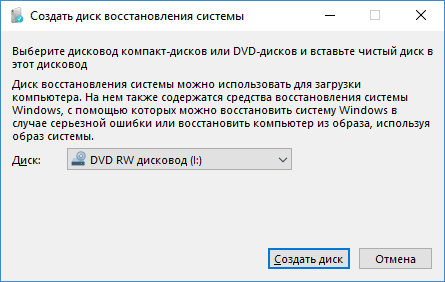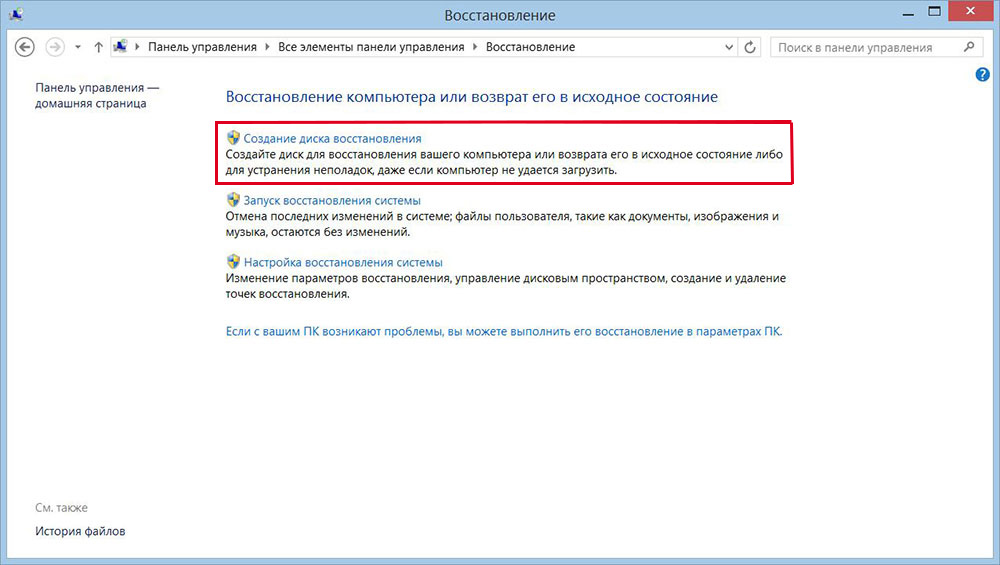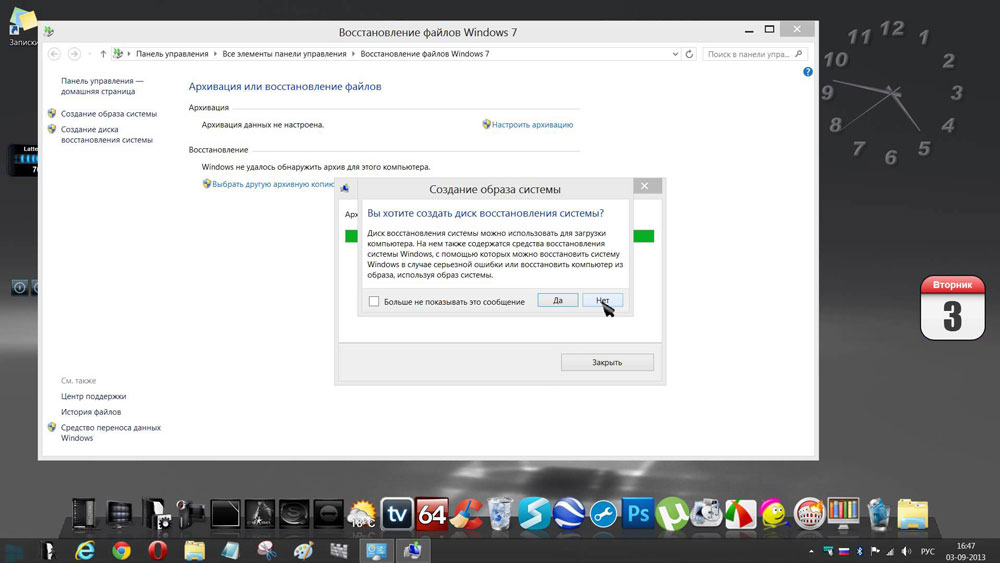- Creating a recovery disc in Windows 10 control panel
- How to create a recovery disc Windows 10 on a CD or DVD
- Using a bootable flash drive or Windows 10 disk for recovery
This tutorial details how to create a disc. windows recovery 10, as well as how to use a bootable USB flash drive or DVD with system installation files as a recovery disk, if the need arose. Also below is a video in which all steps are shown visually.
The Windows 10 recovery disk is able to help in case of various problems with the system: when it does not start, it began to work incorrectly, you need to restore the system by performing a reset (returning the computer to the initial state ) or using previously created.
Many articles on this site mention the recovery disk as one of the tools for solving computer problems, and therefore it was decided to prepare this material. All instructions related to restoring the launch and performance of the new OS can be found in the material.
Creating a recovery disc in Windows 10 control panel
In Windows 10, there is a simple way to make a recovery disk or, more correctly, a USB flash drive through the control panel (the way for CD and DVD will also be shown later). This is done in a few steps and minutes of waiting. I note that even if your computer does not start, you can make a recovery disk on another PC or laptop with Windows 10 (but always with the same bit depth - 32-bit or 64-bit. If you do not have another computer with 10-koy, the next section describes how to do without it).

Done, now you have a recovery disk available by putting the boot from which into BIOS or UEFI (or using) you can enter the Windows 10 recovery environment and perform many tasks of reanimation of the system, including rollback to its original state, if nothing else Does not help.

Note: you can continue to use the USB drive from which the recovery disk was made to store your files if there is such a need: the main thing is that the files already placed there should not be affected. For example, you can create a separate folder and use only its contents.
How to create a recovery disc Windows 10 on a CD or DVD
As you can see, in the previous and mainly for Windows 10 method of creating a recovery disc, such a disc means only a USB flash drive or other USB drive, without the ability to select a CD or DVD for this purpose.
However, if you need to make a recovery disk on a CD, this possibility is still present in the system, just in a slightly different location.

After that you will need to choose a drive with a blank DVD or CD and click "Create Disc" to burn the recovery disc to the optical CD.

Its use will not differ from the flash drive created in the first method - just put the boot from the disk in the BIOS and boot the computer or laptop from it.
Using a bootable flash drive or Windows 10 disk for recovery
Do or install DVD disc With this OS easier than ever. At the same time, unlike the recovery disk, it is possible on almost any computer, regardless of the version of the OS installed on it and the state of its license. In this case, such a drive with the distribution kit can then be used on the problem computer as a recovery disk.
When working with a computer, everything happens; perhaps, each user finds himself in a situation when the OS stopped working partially or completely. As a result, there was a need for a complete reinstall windows that led to the loss of important and not very data. It is unlikely that it will be possible to avoid problems in the system, but it is possible and necessary to make the process of restoring the operating system of the operating system faster and more comfortable. Here you will come to the aid of the recovery function. In this article, we'll figure out how to create a Windows system recovery disk. Let's get started. Go!
To begin with, it should be noted that as a recovery disc, you can use not only a regular DVD, but also a USB flash drive, which in our time will be a more acceptable option.
If you have an operating system installed on your computer windows system 10, this version has the function of creating a recovery flash drive, which allows to do it very easily and quickly. First you need to go to the Computer Control Panel. Among all the menu items, find “Recovery” and click on it. In the window that opens, select the function to create a recovery disk. If you want to backup Windows files, check the corresponding box in the next window. Please note that when this option is activated, the disk space will be larger, however, this will greatly facilitate the entire system reset procedure in the future. Therefore, it is recommended to enable this option. Next, in the USB flash drive selection window, select your USB flash drive. The USB-drive should have a volume of at least 8 gigabytes and at the same time be empty. Otherwise, all data will be erased from it. It remains to click "Next" and wait for the completion of the operation. After that you can use a USB flash drive to store your files and folders. The main condition is not to affect the recorded system files.

Now let's figure out how to make a system recovery disc for Windows 7. This is done as follows. First you need to open the Control Panel and go to the “System and Security” section. Then select "Backup and Restore." In the window that opens, click on "Create system recovery disk." Further steps are very simple - insert a CD or DVD into the drive, then select the drive with the disc and start the process.

Before you start Windows from the recorded media, you must change the boot settings in the BIOS. To do this, go to the BIOS (when turning on the computer, press the Del key or another key, depending on the manufacturer of your PC). Once inside the BIOS, go to the “Boot” section. There you will find an item where you can change the priority of devices from which the OS will boot. Put on the first place an optical disc or flash drive. Save your changes by pressing the F10 key on your keyboard. Now, if any media is detected when the computer starts up, the OS will be loaded from there.
In addition, you can make an image of the system in which all OS files will be stored in compressed form. Please note that in this case the current state of your OS will be recorded. You can burn an image both on the computer's railway and on a CD / DVD, however, it is worth noting that a lot of space is required. To do this, select the corresponding item in the menu, and then select the place where the archive should be saved. Click the “Next” button to start the procedure. You can also use this method if Windows starts to work incorrectly.
The system recovery disc contains several tools for troubleshooting problems on your computer. To use the system recovery disk, follow these steps:
Windows Memory Diagnostic Tool in System Recovery Utility
The Windows Memory Diagnostic Tool is used to check computer memory for errors. You can choose to run the test immediately or at the next booting windows . If you select the option to restart the computer and immediately run the test, be sure to save your work and close all running programs. Checking computer memory may take several minutes. When the test is completed, Windows will automatically restart.
If you recently installed memory modules, make sure that the type of new memory module meets the memory requirements for the motherboard. If the memory meets the memory requirements for the motherboard, or if the memory worked properly before, but the test completed with an error, follow these steps:
Remove and reinstall the memory module into the slot to check if the problem is caused by connection defects.
Remove each memory module, replacing the one that was previously removed.
After removing and reinstalling the DIMM modules, rerun the memory diagnostics.
If the test still fails, replace the defective memory module.
